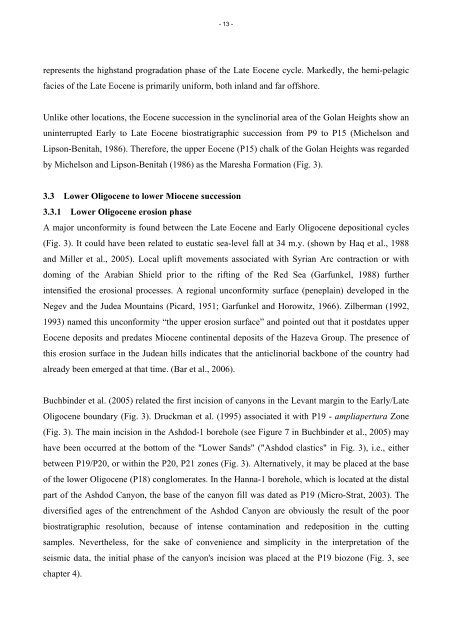The Oligo-Miocene deepwater system of the Levant Basin
The Oligo-Miocene deepwater system of the Levant Basin
The Oligo-Miocene deepwater system of the Levant Basin
Create successful ePaper yourself
Turn your PDF publications into a flip-book with our unique Google optimized e-Paper software.
- 13 -represents <strong>the</strong> highstand progradation phase <strong>of</strong> <strong>the</strong> Late Eocene cycle. Markedly, <strong>the</strong> hemi-pelagicfacies <strong>of</strong> <strong>the</strong> Late Eocene is primarily uniform, both inland and far <strong>of</strong>fshore.Unlike o<strong>the</strong>r locations, <strong>the</strong> Eocene succession in <strong>the</strong> synclinorial area <strong>of</strong> <strong>the</strong> Golan Heights show anuninterrupted Early to Late Eocene biostratigraphic succession from P9 to P15 (Michelson andLipson-Benitah, 1986). <strong>The</strong>refore, <strong>the</strong> upper Eocene (P15) chalk <strong>of</strong> <strong>the</strong> Golan Heights was regardedby Michelson and Lipson-Benitah (1986) as <strong>the</strong> Maresha Formation (Fig. 3).3.3 Lower <strong>Oligo</strong>cene to lower <strong>Miocene</strong> succession3.3.1 Lower <strong>Oligo</strong>cene erosion phaseA major unconformity is found between <strong>the</strong> Late Eocene and Early <strong>Oligo</strong>cene depositional cycles(Fig. 3). It could have been related to eustatic sea-level fall at 34 m.y. (shown by Haq et al., 1988and Miller et al., 2005). Local uplift movements associated with Syrian Arc contraction or withdoming <strong>of</strong> <strong>the</strong> Arabian Shield prior to <strong>the</strong> rifting <strong>of</strong> <strong>the</strong> Red Sea (Garfunkel, 1988) fur<strong>the</strong>rintensified <strong>the</strong> erosional processes. A regional unconformity surface (peneplain) developed in <strong>the</strong>Negev and <strong>the</strong> Judea Mountains (Picard, 1951; Garfunkel and Horowitz, 1966). Zilberman (1992,1993) named this unconformity “<strong>the</strong> upper erosion surface” and pointed out that it postdates upperEocene deposits and predates <strong>Miocene</strong> continental deposits <strong>of</strong> <strong>the</strong> Hazeva Group. <strong>The</strong> presence <strong>of</strong>this erosion surface in <strong>the</strong> Judean hills indicates that <strong>the</strong> anticlinorial backbone <strong>of</strong> <strong>the</strong> country hadalready been emerged at that time. (Bar et al., 2006).Buchbinder et al. (2005) related <strong>the</strong> first incision <strong>of</strong> canyons in <strong>the</strong> <strong>Levant</strong> margin to <strong>the</strong> Early/Late<strong>Oligo</strong>cene boundary (Fig. 3). Druckman et al. (1995) associated it with P19 - ampliapertura Zone(Fig. 3). <strong>The</strong> main incision in <strong>the</strong> Ashdod-1 borehole (see Figure 7 in Buchbinder et al., 2005) mayhave been occurred at <strong>the</strong> bottom <strong>of</strong> <strong>the</strong> "Lower Sands" ("Ashdod clastics" in Fig. 3), i.e., ei<strong>the</strong>rbetween P19/P20, or within <strong>the</strong> P20, P21 zones (Fig. 3). Alternatively, it may be placed at <strong>the</strong> base<strong>of</strong> <strong>the</strong> lower <strong>Oligo</strong>cene (P18) conglomerates. In <strong>the</strong> Hanna-1 borehole, which is located at <strong>the</strong> distalpart <strong>of</strong> <strong>the</strong> Ashdod Canyon, <strong>the</strong> base <strong>of</strong> <strong>the</strong> canyon fill was dated as P19 (Micro-Strat, 2003). <strong>The</strong>diversified ages <strong>of</strong> <strong>the</strong> entrenchment <strong>of</strong> <strong>the</strong> Ashdod Canyon are obviously <strong>the</strong> result <strong>of</strong> <strong>the</strong> poorbiostratigraphic resolution, because <strong>of</strong> intense contamination and redeposition in <strong>the</strong> cuttingsamples. Never<strong>the</strong>less, for <strong>the</strong> sake <strong>of</strong> convenience and simplicity in <strong>the</strong> interpretation <strong>of</strong> <strong>the</strong>seismic data, <strong>the</strong> initial phase <strong>of</strong> <strong>the</strong> canyon's incision was placed at <strong>the</strong> P19 biozone (Fig. 3, seechapter 4).
















